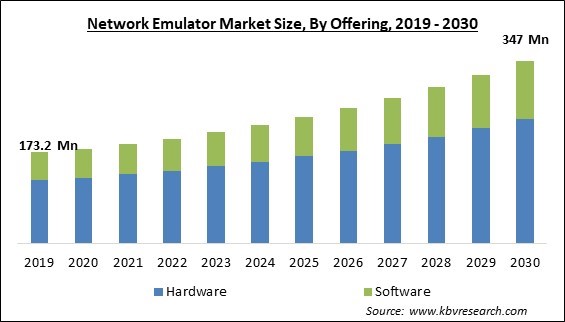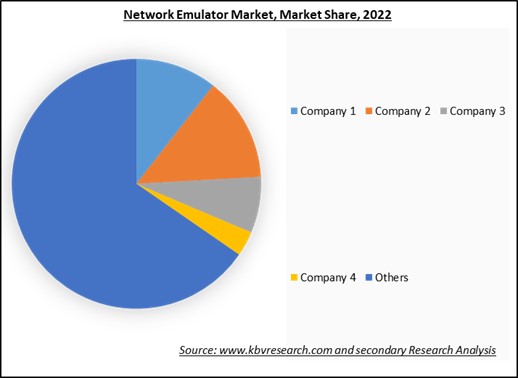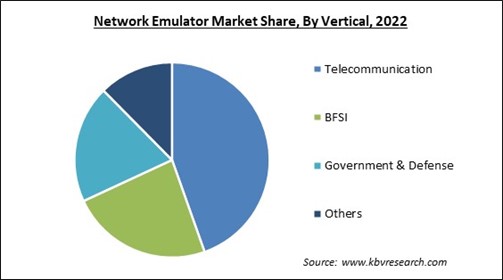The Global Network Emulator Market size is expected to reach $347 million by 2030, rising at a market growth of 7.4% CAGR during the forecast period.
In the era of digitization, the need to enhance the delivery of services to a larger geographic area, along with the demand for high-quality services and sustainable environments, has led to the proliferation of connected devices. Consequently, the IoT & Others segment will capture around 1/4th share in the market by 2030. Moreover, the proliferation of IoT-enabled devices connected to the internet and the rise in global adoption of IoT solutions by sectors have boosted the number of connected devices. Consequently, various end users' development of the market is expected to increase in the coming years as 5G technology and IoT acquire global prominence. Some of the factors affecting the market are the increase in the number of attacks and security breaches on networks, proliferation of data-intensive applications and rapidly changing network and an unskilled workforce.

The growing use of digital solutions and connected devices, which has led to increased cyberattacks and security breaches, emphasizes the vital importance of thorough network performance and security testing. Proper testing becomes crucial to preventing cybercrimes due to the possibility of product vulnerabilities. Emulators play a crucial role by providing virtualized environments for comprehensive testing, ensuring network and device safety in various conditions. This capability enables businesses to troubleshoot, optimize network performance, and design resilient networks. The value of network emulators in boosting security and strengthening against breaches becomes more apparent as cyber threats increase, functioning as a compelling driver for their widespread adoption. Additionally, Data-intensive applications generate and transmit large volumes of data, requiring robust and reliable network performance to ensure a seamless user experience. Network emulators play a crucial role in testing, validating, and optimizing the performance of these applications. It help service providers and content delivery networks (CDNs) test their infrastructure to ensure smooth and uninterrupted video streaming, especially during peak traffic. These emulators allow organizations to proactively identify and address potential issues, ensuring data-intensive applications operate smoothly even in dynamic and challenging network environments.
However, Intense competition among CSPs has resulted from a rapid increase in network data consumption and demand for inexpensive data services, so they must maintain a very low-profit margin on data services. Companies need emulators that can be hyper-scaled in this rapidly evolving network environment, or there needs to be some integration mechanism for network transformation to make it adaptable, which can enhance the performance of network emulators. This issue is especially prevalent in large network deployments. Network emulators cannot test centralized SDN controllers since they are not scaleable for large networks. The effective use of network emulators requires a skilled workforce with expertise in network emulation, network design, and network testing. However, there is often a shortage of professionals with the necessary skills and experience. Training and developing a skilled workforce in this field can be time-consuming and expensive. Hence, such factors pose a challenge for the market.

The leading players in the market are competing with diverse innovative offerings to remain competitive in the market. The above illustration shows the percentage of revenue shared by some of the leading companies in the market. The leading players of the market are adopting various strategies in order to cater demand coming from the different industries. The key developmental strategies in the market are Acquisitions, and Partnerships & Collaborations.
By vertical, the market is segmented into telecommunication, BFSI, government & defense, and others. The BFSI segment projected a prominent revenue share in the market in 2022. Network emulator demand is further fuelled by the BFSI sector's rapid modernization and digitization. As network emulators facilitate infrastructure development that facilitates deliverable services with improved safety, their demand is anticipated to increase in the banking and financial institutions industry in the coming years.

By offering, the market is categorized into hardware and software. The software segment covered a considerable revenue share in the market in 2022. A software-based network emulator is an application or computer program that simulates real-world network conditions and behaviours in a regulated virtual environment. It enables users to examine and analyse the performance, dependability, and security of networked devices, applications, and services by simulating different network factors like latency, bandwidth restrictions, packet loss, and jitter. This emulation helps with development, quality assurance, and validation, allowing for the early detection of problems and optimum performance.
Based on application, the market is classified into SD-WAN, IoT, cloud, and others. The IoT segment garnered a significant revenue share in the market in 2022. IoT applications depend on reliable connectivity and continuous network availability to operate without interruption. Therefore, IoT device development and validation require a testing method that simulates real-world deployments. Network emulators play a crucial role as essential tools in this situation. To provide controlled conditions for rigorous IoT project testing, these emulators precisely develop various network topologies and scenarios.
| Report Attribute | Details |
|---|---|
| Market size value in 2022 | USD 198.9 Million |
| Market size forecast in 2030 | USD 347 Million |
| Base Year | 2022 |
| Historical Period | 2019 to 2021 |
| Forecast Period | 2023 to 2030 |
| Revenue Growth Rate | CAGR of 7.4% from 2023 to 2030 |
| Number of Pages | 236 |
| Number of Table | 350 |
| Report coverage | Market Trends, Revenue Estimation and Forecast, Market Share Analysis, Segmentation Analysis, Regional and Country Breakdown, Companies Strategic Developments, Company Profiling |
| Segments covered | Offering, Application, Vertical, Region |
| Country scope | US, Canada, Mexico, Germany, UK, France, Russia, Spain, Italy, China, Japan, India, South Korea, Singapore, Malaysia, Brazil, Argentina, UAE, Saudi Arabia, South Africa, Nigeria |
| Growth Drivers |
|
| Restraints |
|
Region-wise, the network emulator market is analysed across North America, Europe, Asia Pacific, and LAMEA. In 2022, the North America region led the network emulator market by generating the highest revenue share. The North America region, which consists of well-established nations with robust infrastructures, is a significant demand for network emulator solutions. Strong economies encouraging technology investment help major contributors like the US and Canada. This dominance results from their highly developed industries' capacity to invest in advanced IT infrastructures, establishing favourable conditions for adopting network emulator. Telecommunications providers in the region are being encouraged to incorporate network emulators across network layers by technological advancements like 4G and 5G. High R&D activity is expected, and network emulator deployment is expected to be widespread during the projected period.
Free Valuable Insights: Global Network Emulator Market size to reach USD 347 Million by 2030
The market research report covers the analysis of key stake holders of the market. Key companies profiled in the report include Spirent Communications plc, Keysight Technologies, Inc., Viavi Solutions, Inc., Rohde & Schwarz GmbH & Co. KG, SolarWinds Corporation, Aldec, Inc., Calnex Solutions plc, Marben Products SAS, InterWorking Labs, Inc. and Modulo Communications Systems Ltd.
By Offering
By Application
By Vertical
By Geography
This Market size is expected to reach $347 million by 2030.
Increase in number of attacks and security breaches on networks are driving the Market in coming years, however, Rapid changing network and an unskilled workforce restraints the growth of the Market.
Spirent Communications plc, Keysight Technologies, Inc., Viavi Solutions, Inc., Rohde & Schwarz GmbH & Co. KG, SolarWinds Corporation, Aldec, Inc., Calnex Solutions plc, Marben Products SAS, InterWorking Labs, Inc. and Modulo Communications Systems Ltd.
The expected CAGR of this Market is 7.4% from 2023 to 2030.
The SD-WAN segment lead the Market by Application in 2022 achieving a market value of $148 Million by 2030.
The North America region dominated the Market by Region in 2022 and would continue to be a dominant market till 2030; thereby, achieving a market value of $128 Million by 2030.
Our team of dedicated experts can provide you with attractive expansion opportunities for your business.

